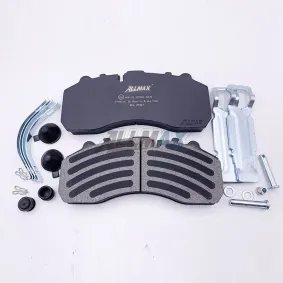Differences Between OEM and Aftermarket Brake Pads for Commercial Vehicles
When it comes to maintaining the safety and efficiency of commercial vehicles, one critical component that often goes unnoticed is the brake system. Brake pads are a crucial part of this system, responsible for ensuring your vehicle comes to a halt when you need it to. However, the decision to choose between OEM (Original Equipment Manufacturer) and aftermarket brake pads is a choice that every fleet manager and commercial vehicle owner must make. In this article, we will delve into the key differences between OEM and aftermarket brake pads for commercial vehicles, helping you make an informed decision that can impact your vehicle's performance, safety, and your bottom line.
Quality and Performance
OEM Brake Pads
OEM brake pads are designed and manufactured by the same company that built your commercial vehicle. This direct association ensures that OEM brake pads are engineered to meet the specific requirements of your vehicle's make and model. The advantage here is that you can expect a high level of quality and performance. These pads are rigorously tested and are optimized for your vehicle's brake system, providing an excellent balance between stopping power and noise control.
Aftermarket Brake Pads
On the other hand, aftermarket brake pads are produced by third-party manufacturers. While they may be more cost-effective, the quality and performance can vary significantly. These pads are designed to fit a wide range of vehicles, which means they might not be as precisely tailored to your commercial vehicle as OEM brake pads. Quality control also varies between different aftermarket manufacturers, which can lead to inconsistencies in performance and durability.
Price Point
OEM Brake Pads
OEM brake pads are often associated with a higher price point compared to aftermarket options. The reason behind this is the meticulous engineering, rigorous testing, and the brand association with the vehicle manufacturer. While they may be more expensive, the initial investment can save you money in the long run by reducing the frequency of brake pad replacements and minimizing potential damage to your vehicle's braking system.
Aftermarket Brake Pads
Aftermarket brake pads are generally more budget-friendly. Due to the wide range of options available, you can find aftermarket brake pads to fit your budget. However, it's essential to consider that the lower cost may also reflect a compromise in quality. Cheaper pads might wear out faster, leading to increased maintenance costs and potential risks associated with brake failure.
Warranty and Support
OEM Brake Pads
Another significant advantage of OEM brake pads is the warranty and support offered by the vehicle manufacturer. When you choose OEM brake pads, you often receive a warranty that covers the product against defects in materials and workmanship. This warranty can provide peace of mind, knowing that you have the backing of the vehicle manufacturer in case of any issues.
Aftermarket Brake Pads
While some aftermarket brake pad manufacturer offer warranties, they typically don't match the coverage provided by OEMs. Moreover, navigating warranty claims with aftermarket parts can sometimes be more challenging, as the responsibility may fall on the third-party manufacturer rather than the vehicle manufacturer. This can result in a longer downtime for your commercial vehicle.
Availability and Compatibility
OEM Brake Pads
Finding OEM brake pads is relatively straightforward, as they are often available at authorized dealerships and service centers. These pads are designed specifically for your vehicle, ensuring a perfect fit and compatibility.
Aftermarket Brake Pads
Aftermarket brake pads are widely available, both online and in various auto parts stores. However, compatibility can be an issue. You must ensure that you select the right brake pad for your specific commercial vehicle, and this can be a time-consuming process. Moreover, variations in quality and compatibility may make aftermarket pads less convenient for some fleet managers.
Environmental Considerations
OEM Brake Pads
OEM brake pads are usually engineered with a focus on environmental standards, using materials that meet regulations and industry standards. This can be a critical factor for businesses looking to reduce their environmental impact and comply with eco-friendly guidelines.
Aftermarket Brake Pads
The environmental considerations regarding aftermarket brake pads can vary greatly. Some manufacturers prioritize eco-friendly materials and production processes, while others may not adhere to such standards. As a result, choosing aftermarket pads with the environment in mind requires careful research and selection.
In the debate between OEM and aftermarket brake pads for commercial vehicles, there is no one-size-fits-all answer. The choice depends on your specific needs, budget, and preferences. OEM brake pads offer superior quality, performance, and warranty support but come at a higher cost. Aftermarket brake pads provide cost savings but may compromise on consistency and compatibility.
Ultimately, it's essential to weigh the pros and cons carefully and consider the specific requirements of your commercial vehicle. Your decision will impact the safety, efficiency, and long-term maintenance costs of your fleet.
258
0
0



Comments
All Comments (0)